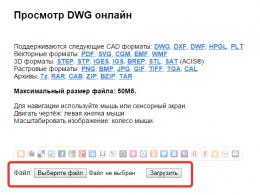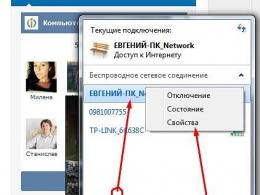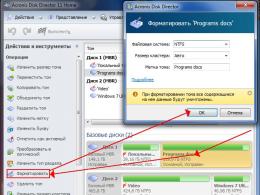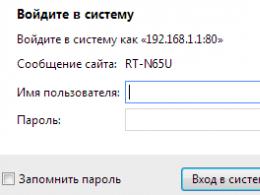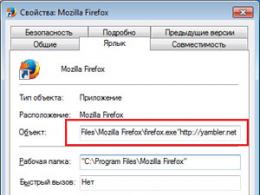Yambler how to remove from chrome. How to remove Yambler (Yambler) from chrome
Quite a lot of users today are interested in how to remove Yambler from Google Chrome, thereby getting rid of the imposed start page in a web browser. However, first of all, you need to know what Yambler is.
So, the site "Yambler" positions itself as a major search engine. The high attendance of this resource, most likely, is provided by a virus that integrates into the browser and changes the home page. As a result, when starting the web browser, the user is redirected to the Yambler.net site.
It is worth noting that such a virus does not harm your computer. However, many "users" want to get rid of it, because it is not very convenient when, instead of the usual Google or Yandex search engines, some incomprehensible resource opens when the browser is launched.
That's why you need to know how to remove Yambler. From Google, as, indeed, from other web browsers, you can remove it by performing a few simple manipulations, which will be discussed in this article.
for viruses
If you find that after launching the browser, Yambler opens as the start page, then your first action should be to check the device for viruses. It is possible that when installing any application or extension along with it, malicious software penetrated the computer, which changed the home page in Google Chrome.

Run your antivirus and perform a deep system scan. If a virus is found, remove it or place it in quarantine. In addition, you can use special programs that can solve such problems. Choose, for example, the Malwarebytes application or any other. But remember that it is recommended to download such programs only from official sites.
Change the start page in a web browser
If cleaning the PC from viruses did not help, then you need to know how to remove Yambler from Google Chrome by changing the browser start page. It must be said right away that if you download Google Chrome not from the official site, but from a third-party resource that has a dubious reputation, then, most likely, when you start the web browser, the home page with intrusive ads will open.
So, how to remove "Yambler" from "Chrome"? Very simple:

Yandex.Browser and Google Chrome.
1. Start - write in the search bar %appdata%- Enter. Next, go to the Yandex - YandexBrowser - Application folder.
2. In the folder that opens, you will see files belonging to Yandex Browser itself and some other suspicious files, such as yandex(Internet shortcut), browser.exe and old_browser.exe.
3. Completely delete the file yandex(Internet Shortcut) and rename the file old_browser.exe on the browser.exe with the replacement of the main file.
4. Remove the Yandex shortcut. Browser from the Desktop and create a new one based on the changed data.
In the same way, you can uninstall Yambler in Google Chrome.
Mozilla Firefox.
1. Go to the folder
C:\Program Files\Mozilla Firefox\
and delete all files with .url extension.
2. Right-click on the browser shortcut - Properties - correct the object name from .url to .exe.
1. Go to the folder
C:\Program Files\Opera\
and also delete all .url files in this directory.
2. Right click on the Opera shortcut on the desktop, go to properties and rename launcher.url to launcher.exe.
After all the manipulations with browsers, run the Ccleaner program and clean the registry and all the garbage on the PC.
No comments yet
Today I helped a neighbor remove a virus that changed the address of the start page in the Mozilla FireFox browser. Imagine that you open your browser and instead of the usual start page, you find some left site. Hmm, the start page has changed - a mess! Not understanding how this could happen, you will change the address to the previous one. However, the next time you start the browser, everything repeats. Now for the majority the situation will become clearer, isn't it? That's right, it's a virus. In our case, the site smaxxi.biz was opened, but, as it turned out, this site has a variety of addresses: smaxi.net, smaxi.biz, etc. In general, I suspect that less similar names are possible. There are also concerns that the problem is also relevant among users of other browsers (Chrome, Internet Explorer, Opera). Therefore, in this article I want to tell you how to get rid of this dirty trick. Perhaps someone will find the instructions useful.
Getting rid of the virus
First way. For the lazy (just kidding). Let's call it "comfortable".
Return back the start page you need and close the browser.
Additional steps if using the Mozilla FireFox browser: In the address bar of the browser, point to the page about:config and open it. When asked “is it really necessary,” promise that you will be careful. A long list of settings will appear. In the Filter line, enter the address of the site that substitutes the virus. The list of settings will be cleared and only those lines will remain where the malicious site is specified as a parameter. Double-click on the lines to remove its address from the parameter value.

It has already become a tradition on our site to recommend the free CureIt utility. But what if the program really helps in most of the unpleasant cases associated with the registration of malware in the system? She did it this time too. The only thing I can advise to save time is that at the seventh stage it is not necessary to carry out a full check, it will be enough to use the “Selective” option. Just specify one of the scan paths, depending on the version of Windows:
Windows XP- C:\Documents and Settings\[Username]\Application Data\
Windows 7- C:\Users\[Username]\AppData\
Usually, the body of the virus resides in the user's folder, but just in case, you can run a full scan.
The second way. For those who like to dig into the system and spoil something(joke). Removing the virus manually if CureIt did not find anything.
1. Write down the address of the site that the virus substitutes (of course, if you haven't memorized it yet). In the browser, change the address of the start page to the one you need. For Mozilla FireFox, see the additional steps from the method above.
2. Open "Start - Run" (or "Win+R"), type: msconfig and click OK.

3. In the "System Configuration" window that opens, go to the "Startup" tab. Here is a list of files that should be launched at system startup. Find the items that are located in one of the folders, depending on your version of Windows:
on Windows XP, the path starts with- C:\Documents and Settings\[Username]\Application Data\…
in Windows 7 the path starts with- C:\Users\[Username]\AppData\…
(where [Username] is the name of your login account)
Note the paths and names of these files. Uncheck them and click OK.
4. Turn on the display of hidden files and folders in Explorer (instruction).
5. Navigate to the folders found in the third step and delete the files listed in the autoload.
6. Just in case, we will look for and remove references to a bad site from the system registry. We launch the registry editor: "Start - Run" (or "Win + R"), enter: regedit and click "OK". In the left part of the registry editor window that opens, select "Computer" and press "Ctrl + F". In the search box, enter the address of the annoying site, click "Find Next". When a line with the specified site is found, the search will stop and the cursor mark will move to this line. Double-click on the line to open the window for changing the key parameter, delete the text line and click OK. Press "F3" to continue searching. Keep searching and remove the mention of the site until a message appears stating that the search is complete.
That, in fact, is all.
Updated 03.10.2013
Sindex.biz, yambler.net Recently, another type of designated dirty trick has become relevant to increase the attendance of sindex.biz and yambler.net resources
I myself did not encounter this, therefore I did not understand it, but judging by the comments, there is a solution from the respected Pavel. For which he is very grateful. So:
1. Go to drive C, open Program Files, open your browser folder, look for files that end with .url and delete;
2. Right-click on the browser icon on the desktop, select Properties, in the name of the file being launched, change the URL ending to EXE;
3. Open Control Panel -> Programs and Features, we look at what is installed last, if you did not set it, delete it. Open the browser, if everything works fine, then:
4. Empty the basket
5. Run the antivirus.
I hope everything works out for you.
Surfing on dubious sites and installing software from an unknown manufacturer on the user's computer does not bode well. One of the most common troubles is installing the Yambler start page in all available browsers in the system. Although this is not a Trojan that steals passwords, but still ... Who would have a desire, instead of the usual Google, Yandex or Bing, to contemplate and even more so use Yambler.net - a cunning search engine with an incredible amount of advertising and links to infected web -pages.
It must be removed as soon as possible for elementary security reasons of the PC and all the data in it.
If your computer still suffers from an ailment called "yambler", do not despair and follow the instructions below. After unpretentious software manipulations, in 15-20 minutes he will be healthy again.
Freeing browsers and operating systems from the malicious resource Yambler.net
1. Edit the label property
At the time of infection, a link to the Yambler is implanted into the browser shortcut, which must be removed first. It is worth noting that it will not work to remove a page with an intrusive service by changing only the standard settings.
Attention! We fix the shortcuts of all installed Internet browsers!
- click on the mouse PC browser icon;
- select the "Properties" option from the context menu;
- in the window that appears, in the "Object" column, we fix "chrome.url" (it is this entry that redirects to the ill-fated yambler) to "chrome.exe".

In the same way, you can remove a malicious link in FF: "Properties" >> "Object". We remove the link to the search engine page (http://yambler.net/) located after "....firefox.exe""". 

Other browsers
In the shortcuts of Opera, Yandex and other browsers, the links redirecting them to Yambler may look different, but this does not change their dirty essence. In the "Object" option, the path to the browser executable file with the .exe extension must be specified. Accordingly, all other "additions" must be removed.
2. We remove malicious files in local folders of web browsers.
Having got rid of the links, let's start destroying the virus objects treacherously located in the directories:
- open the shortcut properties again;
- click the "File Locations" option;
- check your browser files for suspicious shortcuts. They can have the same name as the link in the object entry, or be hidden under other aliases (iexplorer, browser name with url extension). Click the PC (right-click) on the malware and select the "Delete" function (don't forget to empty the Windows trash!).

Control shot at Yambler.net!
Sometimes it happens that the central loader is also involved in creating chaos in web browsers. It settles, as a rule, in the Program Files / (x86) folders. In such a situation, local deletions and fixes will not be enough.
Therefore, better be safe! View the recently installed files in these directories (analyze the date and time in the object's properties). Quite often, hackers call them by names such as "zaxar", "tooldev234", etc. When you see them on your PC, click "Delete" without delay!
Additional prevention
After the above steps, it will not be superfluous to clear the contents of the “Temp” folders, remove suspicious software (if it was recently installed) with special utilities (for example, Revo Uninstaller). And also scan the system and other sections of external media with alternative anti-virus programs: Kaspersky Virus Removal Tool or Dr.Web CureIt!
We wish health to your PC, and you safe Internet surfing!
What could be more beautiful than a weekend morning when all the problems at work are behind you, and besides, Friday evening was not so busy. And now, sitting at a laptop with a cup of morning coffee, I open the browser, and there, instead of my bookmarks, which are necessary for work, the Yambler start page (Yambler). What happened, I asked myself? What is Yambler? Where are my bookmarks? How to remove this Yambler (Yambler)? And in general, where did this Yambler (Yambler) come from?
1) The consequences of the emergence of the Yambler virus (Yambler) net. And so, instead of watching the news, it was decided to study the cause of the appearance of this virus, as well as remove the Yambler (Yambler) address from the start page and generally get rid of this virus.
On the start page of Yambler net, there was an inscription Yambler - relevant search in three search engines at once!
Looking at the statistics of the Yambler net site, we can say that the creators of this site decided to promote it with the help of a virus that is now on my computer. How he got here is not known.
Some information about the Yambler net site:
As you can see from the screenshot at the time of this writing, the site is 7 months and 7 days old
And the statistics of visits show that the number of infected computers is increasing rapidly.
After searching the Internet for the query "Yambler how to remove", users complained that many antiviruses do not block this virus, and the Yambler net address is displayed on the browser's start page as the default. Regardless of which browser you have opened, the default browser will open and the Yambler net start page will open.
It seems that they figured out the consequences of the virus and the main question remains "how to remove Yambler (Yambler)?"
2) How to remove Yambler (Yambler). On my laptop, in addition to the standard Internet explorer browser, two more browsers are installed - this is Mozilla firefox, which is used by default for browsing web pages, and the Opera browser. Whichever browser I open, "Mozilla firefox" opens for me, with the Yambler net page. I decided to look at the properties of the "Opera" browser shortcut and what do you think I found?
Opening the C:\Program Files (x86)\Opera folder, I found this object.
It is this object that links to the Yambler net page.
Same story with "Internet explorer" browser:
To treat the computer, this shortcut must be removed, as well as the shortcut from the desktop and the start menu. Now you can create new browser shortcuts on the desktop, where the new correct path will be indicated, and the Yambler start page will disappear, but you should still do a full scan of your file system for viruses.
You must also delete the folder located in program files, folder name zaxar.
I would suggest reinstalling all installed browsers on your computer. What actually I tried to do, but it did not work out through the standard menu to remove the browser. There was a message stating that this browser is in use and the browser should be closed before deleting it.
Having opened the "Task Manager" (key combination CTR + ALT + DEL), I saw that all my installed browsers are used by the system.
Having completed these processes, it was still possible to remove the browser, and after reinstalling the yambler virus no longer bothers.



